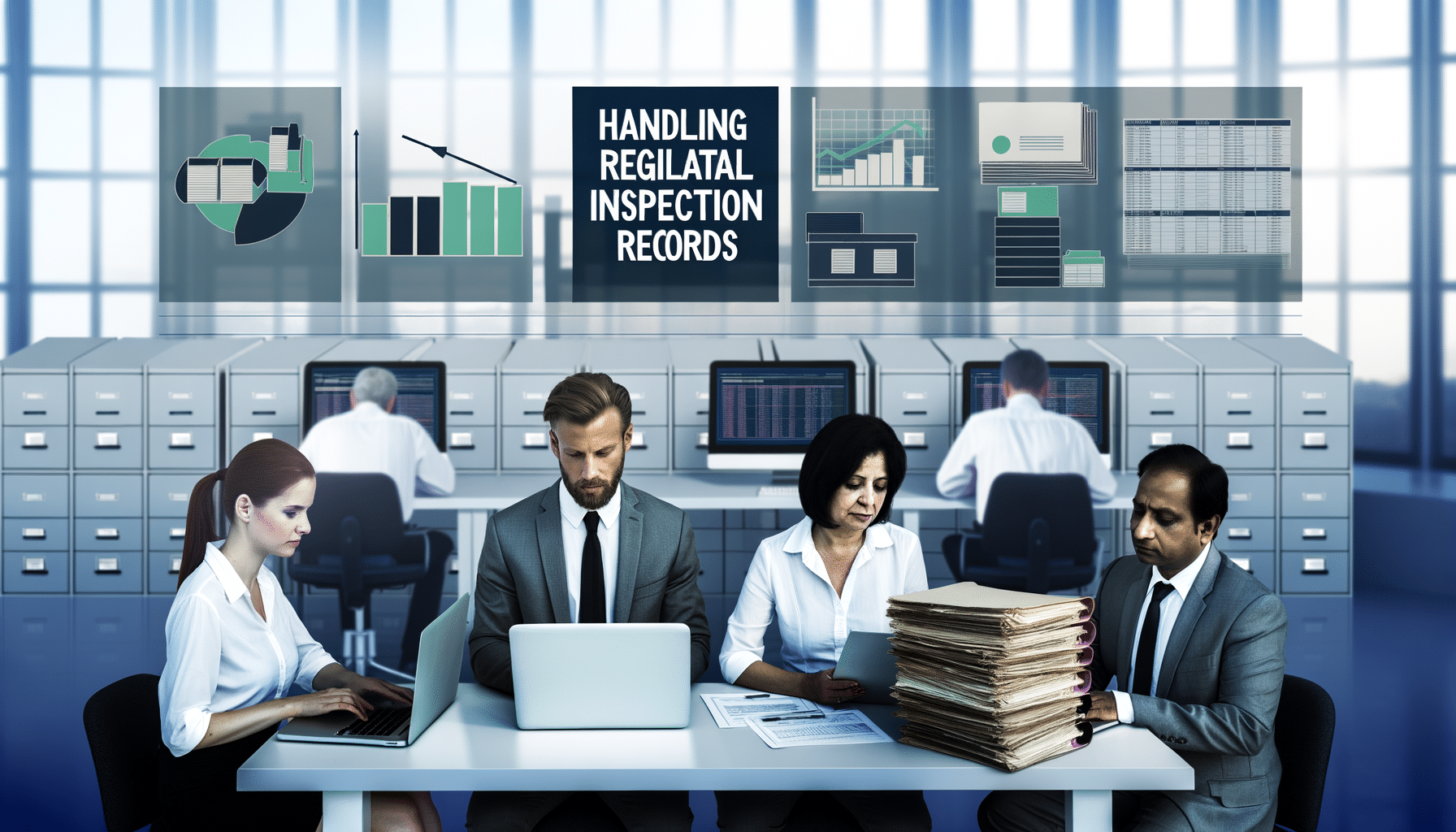- Blockchain Compliance
- January 3, 2025
Handling Regulatory Inspection Records

The Art of Managing Regulatory Inspection Records
Every organization, irrespective of its industry, faces the inevitable specter of regulatory inspections. The very thought of it often conjures images of auditors poring over stacks of paperwork, where even a single misplaced document can create chaos. But what if there was a transformative way to handle regulatory inspection records efficiently, systematically, and with utmost precision? That’s where my vision for RecordsKeeper.AI came into play.
Why Regulatory Inspections Matter
Regulatory inspections are not just procedural formalities. They are critical evaluations that ensure a business complies with industry norms, legal mandates, and ethical standards. From my journey as an entrepreneur, I recognize that a seamless approach to managing these inspections can save businesses from hefty fines, reputational damage, and operational disruptions.
So, how can one prepare for these inspections with confidence and ease? By turning those overwhelming stacks of paper into a strategic advantage, that’s how.
Modernizing Record Management
The idea of upgrading regulatory inspection records management into a strategic maneuver is something that resonated deeply with me. Back when I was conceptualizing RecordsKeeper.AI, I envisioned a solution that could lift organizations from the mire of disorganization to a haven of streamlined efficiency.
Our platform harnesses the power of AI to automate record categorization. The key here is simplification without sacrificing accuracy. AI ensures that your documents are accurately labeled and stored, making retrieval during audits a matter of seconds. Trust me, once you’ve experienced the peace of mind that comes with having an audit-ready system, there’s no turning back.
Ensuring Data Security and Integrity
In the world of compliance, the security and integrity of records cannot be overstated. Regulatory bodies require that documentation not only be present but also unadulterated and confidential.
This is where the Blockchain integration of RecordsKeeper.AI plays a pivotal role. By storing records on an immutable ledger, it provides indisputable proof of integrity and ensures that every file remains tamper-proof. This blockchain safeguard essentially acts as a digital fortress, bringing unparalleled peace of mind during inspections.
Compliance Management and Automated Workflow
Embracing automation simplifies not just the organization of records but also the management of compliance regulations. Different industries have varied regulatory requirements—whether it’s GDPR, HIPAA, or SOX. RecordsKeeper.AI is engineered to handle these intricacies, automating workflows to maintain compliance effortlessly.
Backup and recovery is another critical aspect. Regular automated backups ensure your data is safe, enabling quick recovery when needed. This feature is a true lifesaver in potential scenarios of data loss or breaches.
The Human Element: Simplified For Success
No technological advancement can truly succeed without considering the human element. Our goal at RecordsKeeper.AI was to create a tool that is intuitive and user-friendly, thus eliminating the steep learning curve often associated with new tech solutions. After all, it’s people who use the technology.
Whether it’s your Legal, Finance, or Compliance heads handling records, our platform has been crafted to integrate seamlessly into the workflow of non-technical users—a significant benefit when gearing up for regulatory inspections.
Unlocking Strategic Advantages
With automated auditing capabilities, any compliance discrepancies or inadequacies are flagged well in advance of actual inspections. This affords organizations the luxury of time to rectify issues proactively rather than reactively. Imagine being able to confidently welcome auditors rather than dread their arrival.
Moreover, detailed Audit Logs & Reports feature enables real-time insights into which documents were accessed and by whom, ensuring transparency and accountability that today’s regulatory frameworks demand.
Conclusion: Embrace the Future of Compliance
Transitioning to an intelligent record management system isn’t just about adhering to regulatory demands—it’s about gaining the upper hand. By leveraging RecordsKeeper.AI, businesses transform the daunting duty of handling regulatory inspection records into a streamlined, efficient process that not only ensures compliance but genuinely enhances productivity and focus on core operations.
Let’s make the shift from merely surviving regulatory requirements to thriving because of them. To explore more about revolutionizing your record-keeping strategy and my journey through this innovative space, follow along. We’ve embarked on an exciting path towards the future, and I invite you to join us on this journey.
Toshendra Sharma is the visionary founder and CEO of RecordsKeeper.AI, spearheading the fusion of AI and blockchain to redefine enterprise record management. With a groundbreaking approach to solving complex business challenges, Toshendra combines deep expertise in blockchain and artificial intelligence with an acute understanding of enterprise compliance and security needs.
Related Posts

Organizing External Auditor Access
Setting up secure access for external auditors.
- December 22, 2024
Tracking Record Access During Audits
Maintaining clear logs of who accessed what during audits.
- November 22, 2024
Archives
- January 2025
- December 2024
- November 2024
- October 2024
- September 2024
- August 2024
- July 2024
- June 2024
- May 2024
- April 2024
- March 2024
- February 2024
- January 2024
- December 2023
- November 2023
- October 2023
- September 2023
- August 2023
- July 2023
- June 2023
- May 2023
- April 2023
- March 2023
- February 2023
- January 2023
- December 2022
- November 2022
- October 2022
- September 2022
- March 2019
Want to get more content like this?
Signup to directly get this type of content to your inbox!!
Latest Post
Managing Records During System Downtimes
- January 5, 2025
Quick-Access Systems for Emergency Records
- January 4, 2025
Handling Regulatory Inspection Records
- January 3, 2025
Setting Up New Employee Record Access
- January 2, 2025





